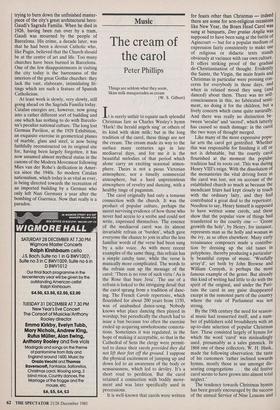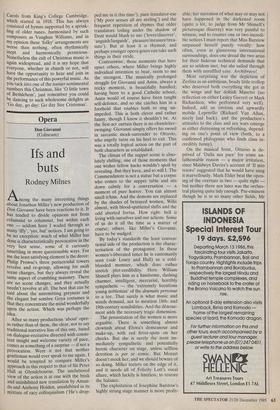Music
The cream of the carol
Peter Phillips
Things are seldom what they seem, Skim milk masquerades as cream (W. S. Gilbert)
It is surely unfair to equate such splendid Christmas fare as Charles Wesley's hymn `Harkl the herald angels sing' or others of its kind with skim milk; but in the long tradition of the carol, these things are not the cream. The cream made its way to the surface many centuries ago in late mediaeval days, and for me it is the beautiful melodies of that period which alone carry an exciting seasonal atmos- phere. Theirs is not a pious Victorian atmosphere, nor a tinselly commercial atmosphere, but a hard unpretentious atmosphere of revelry and dancing, with a healthy tinge of paganism.
The carol originally had only a tenuous connection with the church. It was the product of popular culture, perhaps the surest surviving evidence of how those who never had access to a scribe and could not write, expressed themselves. The essence of the mediaeval carol was its almost invariable refrain or 'burden', which gave everyone the chance to join in after the less familiar words of the verse had been sung by a solo voice. As with more recent examples of the same thing, this refrain has a simple catchy tune, while the verse is musically more complicated. The words to the refrain sum up the message of the carol: 'There is no rose of such virtu / As is the Rose that bare Jesu'. The use of a refrain is linked to the intriguing detail that the carol sprang from a tradition of danc- ing. The French Carole repertoire, which flourished for about 200 years from 1150, was of unabashed dance-song. Nobody knows what place dancing then played in worship; but periodically the church had to issue a ban because too often the exercise ended up acquiring unwholesome connota- tions. Sometimes it was regulated, in the hope of making it acceptable, so that in the Cathedral of Sens the clergy were permit- ted to dance their carols provided they did not lift their feet off the ground. I suppose the physical excitement of jumping up and down led to an awareness of the body or sensuousness, which led to devilry. It's a short road to perdition. But the carol retained a connection with bodily move- ment and was later specifically used in processions.
It is well-known that carols were written for feasts other than Christmas — indeed there are some for non-religious occasions like New Year, the Boars Head Carol was sung at banquets, Dec gratias Anglia was supposed to have been sung at the battle of Agincourt — but for a popular medium of expression fairly consistently to make use of religious or didactic texts stands obviously at variance with our own culture. It offers striking proof of the gradual de-Christianisation of thought. Evidently the Saints, the Virgin, the main feasts and Christmas in particular were pressing con- cerns for everybody in those days, and when in relaxed mood they sang (and danced) about them. There was no self- consciousness in this, no fabricated senti- ment, no doing it for the children, but a lively concern which came quite naturally. And there was really no distinction be- tween 'secular' and 'sacred', which latterly has caused so much damage: in the carol the two ways of thought merged.
Like many of the more expressive popu- lar arts the carol got gentrified. Whether this was responsible for finishing it off or not is debatable, but the courtly carol flourished at the moment the popular tradition had its roots cut. This was during Henry VIII's reign. With the dissolution of the monasteries the vital driving force in the carol was lost, not on account of the established church so much as because the mendicant friars had kept closely in touch with the ordinary laity, and they had contributed a great deal to the repertoire. Needless to say, Henry himself is supposed to have written some carols, and these show that the popular view of things had transferred to the courtly one — `Grene growith the holy', by Henry, for instance, represents man as the holly and woman as the ivy, as so often elsewhere. Many early renaissance composers made a contribu- tion by dressing up the old tunes in polyphony, thereby producing a particular- ly beautiful corpus of music. 'Woefully array'd', set both by John Browne and William Cornysh, is perhaps the most famous example of the genre. But already this kind of writing had little to do with the spirit of the original, and under the Puri- tans the carol in any guise disappeared except in the remotest parts of the country where the rule of Parliament was not strong.
By the 19th century the need for season- al music had reasserted itself, and a num- ber of publishers sold broadsheets with an up-to-date selection of popular Christmas fare. These consisted largely of hymns for which the word 'carol' was misleadingly used, presumably as a sales gimmick. In 1868 one of these collectors, W. H. Husk, made the following observation: the taste of his customers 'rather inclined towards hymns, mostly those in use amongst dis- senting congregations . . . the old festive carol seems to have grown into almost total neglect.'
The tendency towards Christmas hymns has been greatly encouraged by the success of the annual Service of Nine Lessons and Carols from King's College Cambridge, which started in 1918. This has always consisted of hymns supported by a sprink- ling of older tunes, harmonised by such composers as Vaughan Williams, and in my opinion these 'folky' arrangements are worse than nothing, often rhythmically inept and harmonically pernicious. Nonetheless the cult of Christmas music is again widespread, and it is my hope that everyone, whether in church or not, will have the opportunity to hear and join in the performance of this powerful music. As You tuck into one of the nastier sentimental numbers this Christmas, like '0 little town of Bethlehem', just remember you could be dancing to such wholesome delights as `Go day, go day: Go day Sire Cristemas'.



















































































 Previous page
Previous page